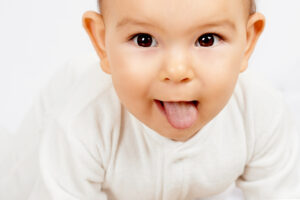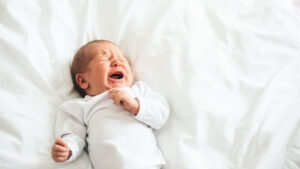 Babies and small children haven't had the chance to build up their immune systems so can get sick quite often. Looking after a poorly child, even for a couple of days, is exhausting. Get rest and sleep when you can. The NHS has a guide on the symptoms of the most common infectious diseases and advice on what to do if your child is unwell.
Babies and small children haven't had the chance to build up their immune systems so can get sick quite often. Looking after a poorly child, even for a couple of days, is exhausting. Get rest and sleep when you can. The NHS has a guide on the symptoms of the most common infectious diseases and advice on what to do if your child is unwell.
Trust your instincts if you think your baby is seriously unwell or their crying is unusual, contact NHS 111 for advice.
Call 999 or go to A&E if a baby or young child is not responding to you, not breathing normally, or has any of these symptoms of sepsis:
- blue, pale or blotchy skin, lips or tongue
- a rash that does not fade when you roll a glass over it, the same as meningitis
- difficulty breathing (you may notice grunting noises or their stomach sucking under their ribcage), breathlessness or breathing very fast
- a weak, high-pitched cry that's not like their normal cry
- not responding like they normally do, or not interested in feeding or normal activities
- being sleepier than normal or difficult to wake.
You can find out more about common ailments below.
 Your newborn baby's skin is very delicate. It's better to use plain water to wash your baby initially but if needed, you can use a mild, non-perfumed soap. Avoid skin lotions, medicated wipes and bubble bath at this early stage. Premature babies' skin is even more delicate. Find out more about babies who need special care or ask the staff in the neonatal unit for advice.
Your newborn baby's skin is very delicate. It's better to use plain water to wash your baby initially but if needed, you can use a mild, non-perfumed soap. Avoid skin lotions, medicated wipes and bubble bath at this early stage. Premature babies' skin is even more delicate. Find out more about babies who need special care or ask the staff in the neonatal unit for advice.
Babies often get red, scaly skin known as eczema. The symptoms are patches of red, dry and itchy skin on the face or behind the ears, and in the creases of the neck, knees and elbows. Your baby may scratch the itchy patches sometimes leading to an infection. In Asian and black Caribbean or African children, eczema may affect other areas rather than the skin creases.
Atopic eczema (atopic dermatitis) is the most common form of eczema, a condition that causes the skin to become itchy, dry and cracked. Atopic eczema is more common in children, often developing before their first birthday.
Treatments for atopic eczema can help to ease the symptoms. The main treatments are:
- emollients or moisturisers - used every day to stop the skin becoming dry
- topical corticosteroids - creams used to reduce swelling and redness during flare-ups.
As well as the treatments mentioned above, there are things you can do yourself to help ease symptoms and prevent further problems: use unperfumed soaps, lotions or emollients and get into a routine of applying these regularly.
Most babies eventually grow out of eczema and dry skin conditions. Speak to your GP or health visitor if you are need more support, especially if you are considering cutting out important foods such as milk, dairy products, wheat or eggs from your child's diet.

Oral thrush is a common fungal infection in the mouth and can sometimes happen after you or your baby has had a course of antibiotics.
Signs of oral thrush:
- White spots or patches on your baby's cheeks, gums, and palate. These patches can look like milk spots, but if you rub them there will be a raw area underneath.
- Your baby may fuss when breastfeeding, or might even refuse your breast or their bottle.
- If you are breastfeeding, you may also have thrush on your nipples, making them painful, red and cracked.
- Your baby may get persistent nappy rash. It might look red or bright pink with small raised red spots and you might find standard nappy rash creams aren't effective in clearing the rash.
If your baby has oral thrush which doesn't clear up within a few days, they may need to be prescribed an anti-fungal treatment. Make an appointment with your GP or health visitor who can diagnose and treat you both. It's important that both baby and mum are treated at the same time to make sure you don't keep passing the infection back and forth.
Oral thrush will usually become less of a problem as your baby 's immune system matures. Although there is no evidence that thrush can be prevented, it is advisable to take care when sterilising bottles, dummies and other feeding equipment.
 Reflux is when a baby brings up milk, or is sick, during or shortly after feeds. It's very common and usually gets better on its own. Reflux is different to vomiting - if your baby vomits, their muscles contract noticeably. With reflux, the milk travels back up the food pipe very easily.
Reflux is when a baby brings up milk, or is sick, during or shortly after feeds. It's very common and usually gets better on its own. Reflux is different to vomiting - if your baby vomits, their muscles contract noticeably. With reflux, the milk travels back up the food pipe very easily.
Symptoms of reflux:
- Bringing up milk or being sick during or shortly after feeding
- Coughing or hiccupping when feeding
- Being unsettled during feeding
- Swallowing or gulping after burping or feeding
- Crying and not settling
- Not gaining weight as they're not keeping enough food down.
Sometimes babies may have signs of reflux, but won't bring up milk or be sick. Instead the milk is swallowed back down. This is known as silent reflux and can be harder to identify as there are no obvious symptoms.
In most babies, as long as they are healthy and gaining weight as expected, reflux is nothing to worry about. If your baby has difficulty feeding or refuses to feed, regularly brings milk back up and seems uncomfortable after a feed, please contact your local health visitor or GP who will be able to support you. They'll be able to give you practical advice on how to ease the symptoms and manage it.
Babies should always be put flat on their back to go to sleep. They should not be put onto their tummies or sides to go to sleep.
 When a baby cries a lot, but otherwise appears to be happy and healthy, it could be colic. Colic is very common and should get better on its own. Colic usually only lasts during the baby's first few months. You can learn more about the symptoms of colic and some practical ideas to comfort a child with colic at NHS.uk.
When a baby cries a lot, but otherwise appears to be happy and healthy, it could be colic. Colic is very common and should get better on its own. Colic usually only lasts during the baby's first few months. You can learn more about the symptoms of colic and some practical ideas to comfort a child with colic at NHS.uk.
Having a colicky baby can be distressing for the parents. Remember that it will pass but get help it you need it. Cry-sis provides a helpline for parents of children with crying or sleepless babies. You can call them on 0845 122 8669 (9am to 10pm, seven days a week) or phone your local Health Visiting Team for more support.
 Nappy rash is very common. It can be caused by:
Nappy rash is very common. It can be caused by:
- your baby's skin being in contact with wee or poo for a long time
- the nappy rubbing against your baby's skin
- not cleaning the nappy area or changing the nappy often enough
- soap, detergent or bubble bath
- alcohol-based baby wipes
- your baby recently taking antibiotics.
You can usually treat their skin yourself by applying a thin layer of a barrier cream to protect their skin at each nappy change. Ask your health visitor or pharmacist to recommend one.
If the rash is severe your baby may become uncomfortable or distressed. If you have concerns and require any support please contact your local health visitor.
Other rashes in the nappy area
If the rash doesn't go away or your baby develops a persistent bright red, moist rash with white or red pimples that spreads into the folds of their skin, they may have an infection. If the rash is severe, take your baby to the GP who may prescribe cream or medicine.
Useful resources
- NHS.uk has a guide on the symptoms of the most common infectious diseases and advice on what to do if your child is unwell.
- Trust your instincts if you think your baby is seriously unwell or their crying is unusual, contact NHS 111 for advice.
- St. Johns Ambulance has some great first aid resources you might find useful.
- The Baby Check app has 19 simple checks that can help you decide if your baby needs to see a health professional.
- Come along to a child health clinic for advice, information and support for you and your child's health and development from your local Health Visiting Team.
Page last reviewed: 01/01/2025, next review due: 01/01/2028